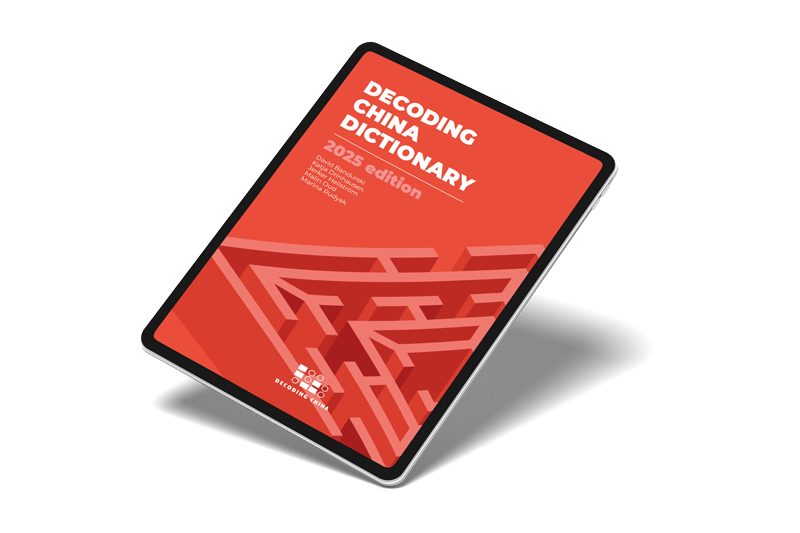
KEY TERM
Aid
[ 援助 ]
[ 援助 ]
Aid

Aid is seen not as charity but as mutually beneficial “development cooperation” serving pragmatic and strategic aims. It advances China’s interests through reciprocity, without imposing conditions on governance or human rights.
Brief
In Europe, as in other major industrialised donor countries, aid is broadly understood as the transfer of resources from rich (donor) to poorer (developing) countries to promote social and economic development. A common view is that aid should be charitable, or at least contain a gift element, though in practice it has often been shaped by the political, strategic, and economic interests of donors.
In Chinese usage, by contrast, “aid” is largely conceived as mutual and reciprocal. Official discourse distinguishes between Western “development aid” (发展援助) and Chinese “foreign aid” (对外援助) to stress that China is not a “donor country”. Instead, it defines its aid as South-South Cooperation, framed in terms of “equality”, “friendship” and “mutual benefit”. While aid may be reciprocated directly through goods or resources, politically, it is linked to relational power: recipients are expected to return the favour by supporting Chinese positions, for example in international organisations.
Analysis
The first recipients of Chinese foreign aid were North Korea and North Vietnam in 1950. After the Bandung Conference of 1955, aid was extended to recently decolonised countries. From the outset, it was a strategic tool to help break China’s international isolation: economic aid was reciprocated with diplomatic recognition, and vice versa. Zhou Enlai explained in 1956 that despite China’s poverty it was helping others because “we have understood that economic independence is fundamental to political independence” – meaning independence from the West. On a 1964 tour of ten African countries, Zhou promulgated the “Eight Principles of Chinese Foreign Aid”, the core of which – that aid should not be tied to any political conditions except for the non-recognition of Taiwan – still applies today. Foreign aid also helped the PRC secure the China seat in the UN in 1971 with the support of developing countries, while Taiwan was excluded.
With Reform and Opening in 1978, high levels of aid spending came under scrutiny, as China – then among the world’s 20 poorest countries – needed the scarce resources for its ambitious development. Yet Deng Xiaoping concluded that giving aid was a strategic necessity. In 1980, the State Council noted, referring to China’s UN accession: “China helped others, and they supported us [in return]. The international status China has achieved is inseparable from the support of friendly countries.”[1] The assumption was that since aid was reciprocated in the past, it would be reciprocated in the future. Following this logic, Chinese aid rose sharply again after 1989, when international sanctions followed the Tiananmen Square crackdown and Taiwan sought to re-enter the UN in 1990. To this day, Chinese officials stress to African leaders how grateful China is to “African friends who supported China […] in restoring its rightful seat in the United Nations.”
In Chinese discourse, “aid” is a broadly defined concept: almost anything within the logic of “you need it – we have it” can be called aid. It can mean helping countries fight poverty, or foreign investment and construction by Chinese companies supported by export subsidies. Since aid is often bundled with trade and investment, all Chinese development finance, whether commercial or concessional, may appear as aid to recipients. Official Development Assistance (ODA) databases in Cambodia and the Philippines, for instance, include both concessional loans and non-aid preferential export buyer’s credits from China. This makes Chinese aid appear bigger than it actually is, also relative to DAC donors.
The Chinese approach to aid is pragmatic rather than charitable. A controversy that illustrates the different understandings erupted early in the COVID-19 pandemic in 2020, when China sent protective gear to Italy labelled “The friendship road knows no borders.” While Italy’s Five Star Movement presented it as a “gift”, journalists accused China of masking commerce as generosity. Yet, Foreign Minister Wang Yi stated that China was willing to provide aid by exporting medical supplies despite domestic shortages – suggesting the misunderstanding lay with Europe. For China, export was aid.
When giving aid, China certainly expects reciprocation. But by ascribing to developing countries the ability to reciprocate, it symbolically creates relations of equals – a dimension often overlooked in the West.
[1] Party Literature Research Centre of the CCPCC (PLRC). 1982. “中共中央、国务院关于认真做好对外援助工作的几点意见 (1980 年 11 月 8 日)” [Several Suggestions by the CCPCC and the State Council on Doing Good Work in Foreign Aid (8 November 1980)]. In: 三中全会以来重要文献汇编 第1卷 [Collection of Important Documents since the Third Plenum. Volume 1], 727–29. Beijing: Renmin Chubanshe.
How to cite this article:
Related Articles That Might
Interest You






